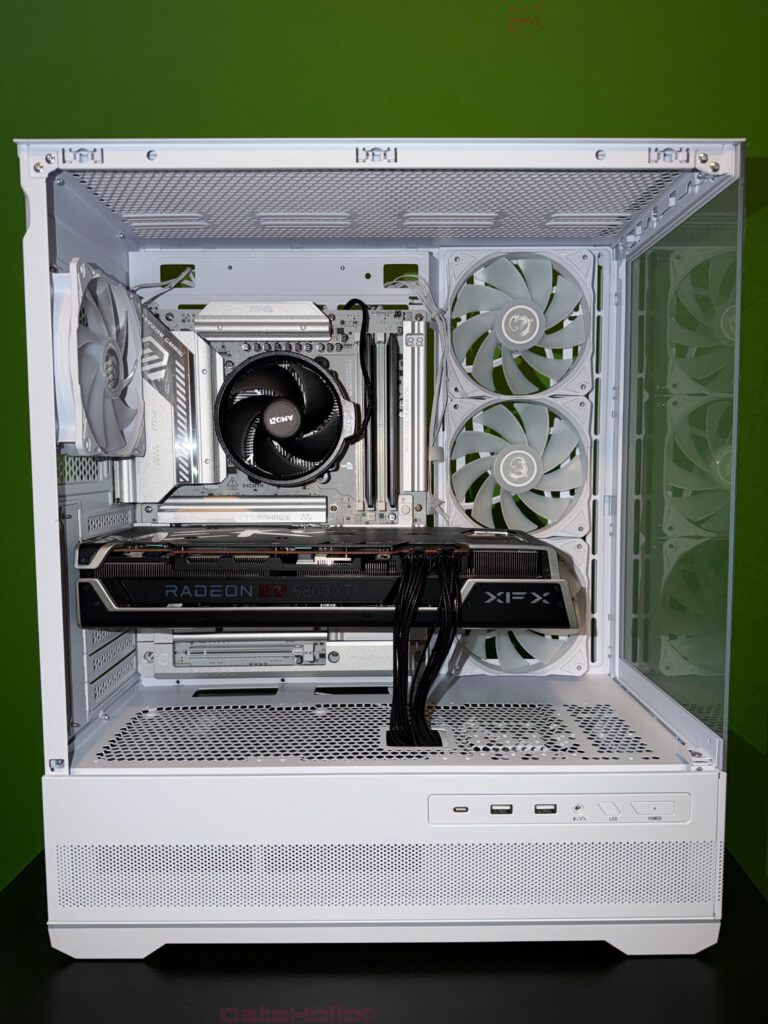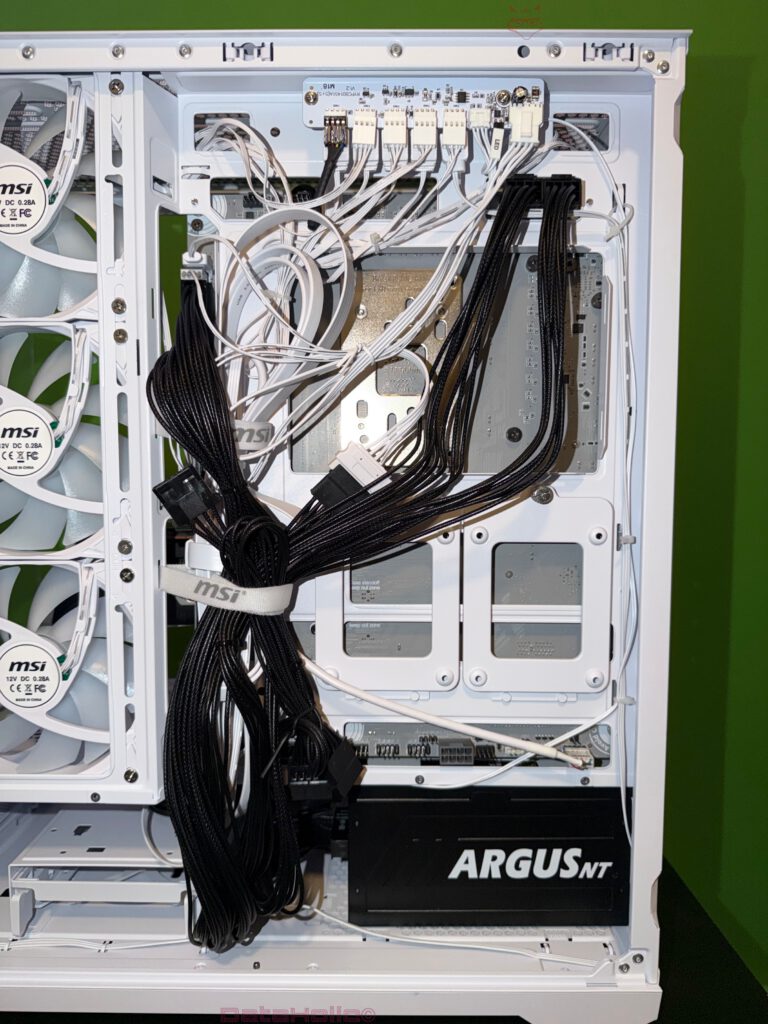Conclusion of the MSI MAG X870E Tomahawk Max WiFi PZ (Project Zero)
At the end of this review, one impression stands out above all: The MSI MAG X870E Tomahawk Max WiFi PZ is one of those motherboards you install, raise an eyebrow for a second – and then forget about, simply because it quietly does its job. And that alone is already a big compliment. No RAM drama, no voltage spikes, no boot loops with a high-end Ryzen 9 – the board feels mature, solid, and refreshingly unproblematic.
At the same time, there’s so much tech packed into it that you might catch yourself wandering through the BIOS menus and wondering if you really need every option. But that’s a luxury problem. Or, to borrow a line from Douglas Adams: “Don’t Panic” – the Tomahawk Max WiFi PZ guides you through, even when you dive deeper.


Test System – The Basis of All Impressions
Before we dive into the details, here’s the hardware foundation used for all tests and observations:
| Hardware | Manufacturer / Model |
|---|---|
| Mainboard | MSI MAG X870E Tomahawk Max WiFi PZ (Project Zero) |
| CPU | AMD Ryzen 9 9900X |
| RAM | Crucial Pro DDR5 64 GB Kit (4×16 GB) 6000 MHz |
| SSD | Kingston 2 TB PCIe 4.0 NVMe M.2 |
| CPU Cooler | AMD Wraith Cooler |
| Graphics Card | AMD Radeon RX 6800 XT |
| Power Supply | MSI MPG A1000GS PCIe 5 |
| Case | MSI MPG Pano 110R PZ |
| Display | LC-M27UFD |
| Keyboard | Dygma Defy |
| Mouse | Logitech MX Vertical |
| Mousepad | MSI True Gaming |
This setup represents a classic high-end gaming and workstation build, the kind many enthusiasts would choose with a Ryzen 9000 CPU and a strong Radeon GPU.
Stability: The Board That Just Runs
Stability is boring – until you don’t have it. The X870E Tomahawk Max WiFi PZ handled hours of heavy CPU load, gaming sessions, and RAM stress tests without a single hiccup. Not surprising when you look at the foundation: a 14+2+1-phase VRM with 80A smart power stages, dual 8-pin EPS, and an eight-layer PCB with 2-oz copper.
In short: The power delivery is far beyond what a Ryzen 9 9900X demands in daily use. Even under extended load, VRM temperatures remained relaxed. The Wraith cooler struggled – as expected with a CPU like the 9900X – but that’s AMD’s heat output, not the board’s fault.
A small anecdote from testing: After the first stable OC profile (slightly elevated all-core boost, refined Curve Optimizer settings), the board could have acted up. Most boards do. Instead, it booted as if nothing happened. No boot loops, no forced CMOS resets. Exactly the behavior you want from a “workhorse board” you rely on.
Design & Project Zero: As Clean as an IKEA Showroom
The most striking feature is, of course, the Project Zero design: Most connectors – 24-pin ATX, EPS, SATA, fan headers, RGB – are moved to the back of the motherboard. In the matching Pano 110R case, this creates a front view where almost nothing distracts from the hardware itself. Cable clutter? Practically only behind the motherboard tray.
During the first build it feels almost wrong. You flip the board, try to plug in the 24-pin, and think: “Wrong side.” After two or three connectors, it clicks. From that point on, the system is so clean that any small deviation becomes visible – like a single pen lying on a spotless desk.
Visually, the fully silver finish can polarize. Some love the “spaceship aesthetic,” others would prefer more contrast. But together with the white/silver Project Zero case, it creates an extremely coherent look. The near-total absence of RGB on the board itself fits that philosophy – the hardware is meant to shine here, not a rainbow show.

Connectivity: PCIe 5.0, M.2 & USB – Nothing Essential Missing
Anyone choosing an X870E motherboard expects one thing above all: future readiness. The Tomahawk Max WiFi PZ delivers exactly that.
- PCIe 5.0 x16 for the GPU – still luxury today, highly relevant tomorrow.
- PCIe 5.0 M.2 slot (Lightning Gen 5 x4) for next-gen NVMe SSDs, plus multiple PCIe 4.0 slots with EZ-M.2 Shield Frozr cooling.
- USB up to 40 Gbps (USB4 / USB 3.2 Gen 2×2) – great for fast external SSDs and docks.
- 5G LAN (Realtek RTL8126) plus Wi-Fi 7 with Bluetooth 5.4 – absolutely up-to-date network hardware.
In real-world use, this means: Even with several fast M.2 drives, a strong GPU, a capture card, and an audio interface, bandwidth bottlenecks are rare. Lane distribution is sensible, and shared bandwidth situations are minimal – a quick look at the manual is enough to know where everything fits best.
A small but incredibly useful detail: EZ PCIe Release. A tiny mechanism that lets you remove the GPU without finger gymnastics or tools wedged between heatsink and slot. One of those “you don’t appreciate it until you need it” features.
Memory & RAM Tuning: DDR5 Without the Breakdown
On paper, the board supports DDR5 up to 8400 MT/s (OC) and up to 256 GB across four DIMM slots. Our 64 GB kit at 6000 MHz sits comfortably below that. The real question: How difficult is memory configuration?
The short answer: activate XMP/EXPO, reboot, done.
No long training loops, no endless retries.
If you want to dive deeper, the BIOS includes:
- full timing control,
- voltage adjustment for memory controller and SoC,
- MSI’s Memory Try It profiles.
The RAM menus are structured in a way that makes sense. You’re not dumped into an overclocker-only labyrinth. Adjustments like SoC voltage or MC voltage are easy to find.
A metaphor that fits well: “Overclocking is like cooking – you need to know what you’re doing, but a good recipe helps.” And the Tomahawk’s BIOS offers exactly that recipe.
BIOS & Tuning: Many Options, Little Chaos
MSI has earned a reputation for clean BIOS interfaces, and this model continues that trend.
There’s:
- EZ Mode for the essentials,
- Advanced Mode for anyone who wants full control.
Highlights include:
- detailed voltage and frequency controls for CPU and RAM,
- Curve Optimizer support for Ryzen 7000/8000/9000,
- granular fan control with multiple thermal sources,
- full PCIe and virtualization settings.
The OC engine’s fine-grained clock generator is especially helpful when fine-tuning Ryzen CPUs.
Throughout testing, the BIOS was impressively stable. Even after pushing undervolting settings too far, the board usually recovered automatically – no CMOS jumper acrobatics required. For people who use their PC for both work and play, that stability is a real strength.
Daily Use: Gaming, Work, and a Touch of Future-Proofing
With a Ryzen 9 9900X and an RX 6800 XT, the CPU and GPU are the stars of the show. But a motherboard still influences everyday performance through I/O, responsiveness, and storage speeds.
Gaming performance is exactly where it should be: high FPS in QHD and smooth in 4K depending on the game. The more interesting scenarios are:
- gaming and recording to NVMe simultaneously,
- transferring huge files from an external USB SSD,
- rendering or encoding while multitasking.
The Tomahawk Max WiFi PZ handles all that without feeling sluggish. Even under heavy load, the system stays responsive.
The onboard audio (Realtek ALC4080) combined with MSI’s Audio Boost design is clean, clear, and surprisingly refined for a gaming-oriented board. Not on the level of a standalone DAC, but way above “just fine.”

Thermals & Noise: Staying Cool is a Team Effort
The board comes with:
- extended VRM heatsinks,
- Shield Frozr M.2 heatsinks,
- high-quality thermal pads.
In practice, this means the motherboard is rarely the limiting factor. The Wraith cooler struggled, but the VRMs stayed comfortably within safe margins. The thermal design is clearly built for CPUs with much higher power budgets than ours.
Since so many connectors moved to the back, cable management improves airflow on the front side. Fewer dangling cables mean fewer airflow obstacles – a small but welcome advantage of Project Zero.
Downsides: Every Light Has a Shadow
As good as the board is, a few points are worth mentioning.
1. The all-silver design isn’t for everyone
If you’re used to classic black boards, this might be a shock. In the wrong case it can feel out of place.
2. Project Zero requires a compatible case
Without a Project Zero chassis, the board simply isn’t useful. That limits future case upgrades and reduces flexibility.
3. The BIOS can overwhelm beginners
The abundance of tuning options isn’t a flaw, but newcomers might get lost. Defaults are great, though—so it’s only an issue if you insist on tinkering.
4. Price in the upper segment
With USB4, PCIe 5, Wi-Fi 7, and the Back-Connect design, the board sits in the upper mid-to-high-end price range. Fair for what it offers, but not aimed at budget builds.
Price–Performance and Target Audience
Whether this board is “worth it” depends heavily on your plans.
If you:
- plan to run Ryzen 9000 CPUs,
- want PCIe 5.0 for GPUs and SSDs,
- value Wi-Fi 7 and 5G LAN,
- care about a clean, cable-free build,
then the Tomahawk Max WiFi PZ fits like a glove.
Compared to even pricier X870E motherboards with extreme RGB or niche features, this one feels almost understated. That’s good. The focus here is on power delivery, connectivity, and day-to-day practicality — not unnecessary bells and whistles.
It’s a board for people who work, play, and create on the same system. The kind of user who occasionally tweaks BIOS settings, but doesn’t chase benchmark world records.
A quote that fits nicely:
“Perfection isn’t when there’s nothing left to add, but when there’s nothing left to take away.”
And with the Tomahawk Max WiFi PZ, there’s very little you’d want removed.

Personal Closing Thoughts
After several days with the MSI MAG X870E Tomahawk Max WiFi PZ, one old-fashioned conclusion comes to mind:
This is a motherboard you can trust.
You install it, configure it, fine-tune your profile — and then it just exists. No RAM tantrums, no GPU slot drama, no network issues.
The Project Zero design makes the build cleaner, quieter, and far more pleasant. The VRM power is more than ready for current and future Ryzen generations. The connectivity is broad enough to last several upgrade cycles. And the overall experience is as smooth as you’d hope from hardware in this price bracket.
Sure, if you’re building a budget gaming PC, this is too much board.
But if your system is your workstation, your gaming rig, and your tinkering platform all in one, the Tomahawk Max WiFi PZ shines.
In short:
If you’re ready to invest in a board from this segment and plan to use a Project Zero case, you get a highly stable, future-ready, and refreshingly unobtrusive centerpiece for your next PC.
Transparency Notice (as required by EU guidelines):
The MSI MAG X870E Tomahawk Max WiFi PZ reviewed in this article was provided to us by MSI as a non-binding loan unit for testing purposes. This is not paid advertising.
MSI had no influence on the content, evaluation, or editorial independence of this article. All opinions expressed are based solely on our own hands-on experience.
We would like to thank MSI for providing the motherboard and for their trust in dataholic.de.
